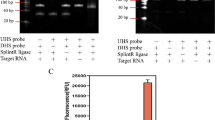Abstract
The use of fluorescent nucleic acid hybridization probes that generate a fluorescence signal only when they bind to their target enables real-time monitoring of nucleic acid amplification assays. Real-time nucleic acid amplification assays markedly improves the ability to obtain qualitative and quantitative results. Furthermore, these assays can be carried out in sealed tubes, eliminating carryover contamination. Fluorescent nucleic acid hybridization probes are available in a wide range of different fluorophore and quencher pairs. Multiple hybridization probes, each designed for the detection of a different nucleic acid sequence and each labeled with a differently colored fluorophore, can be added to the same nucleic acid amplification reaction, enabling the development of high-throughput multiplex assays. In order to develop robust, highly sensitive and specific real-time nucleic acid amplification assays it is important to carefully select the fluorophore and quencher labels of hybridization probes. Selection criteria are based on the type of hybridization probe used in the assay, the number of targets to be detected, and the type of apparatus available to perform the assay. This article provides an overview of different aspects of choosing appropriate labels for the different types of fluorescent hybridization probes used with different types of spectrofluorometric thermal cyclers currently available.


Similar content being viewed by others
References
Förster, T. (1948). Intermolecular energy migration and fluorescence. Annalen der Physik (Leipzig), 2, 55–75. Translated by R. S. Knox.
Haugland, R. P., Yguerabide, J., & Stryer, L. (1969). Dependence of the kinetics of singlet-singlet energy transfer on spectral overlap. Proceedings of the National Academy of Sciences of the United States of America, 63, 23–30.
Higuchi, R., Fockler, C., Dollinger, G., & Watson, R. (1993). Kinetic PCR analysis: Real-time monitoring of DNA amplification reactions. Biotechnology (N Y), 11, 1026–1030.
Wittwer, C. T., Herrmann, M. G., Moss, A. A., & Rasmussen, R. P. (1997). Continuous fluorescence monitoring of rapid cycle DNA amplification. Biotechniques, 22, 130–131.
Nazarenko, I. A., Bhatnagar, S. K., & Hohman, R. J. (1997). A closed tube format for amplification and detection of DNA based on energy transfer. Nucleic Acids Research, 25, 2516–2521.
Kandimalla, E. R., & Agrawal, S. (2000). “Cyclicons” as hybridization-based fluorescent primer-probes: Synthesis, properties and application in real-time PCR. Bioorganic & Medicinal Chemistry, 8, 1911–1916.
Solinas, A., Brown, L. J., McKeen, C., Mellor, J. M., Nicol, J., Thelwell, N., et al. (2001). Duplex Scorpion primers in SNP analysis and FRET applications. Nucleic Acids Research, 29, E96.
French, D. J., Archard, C. L., Brown, T., & McDowell, D. G. (2001). HyBeacon™ probes: A new tool for DNA sequence detection and allele discrimination. Molecular and Cellular Probes, 15, 363–374.
Kutyavin, I. V., Afonina, I. A., Mills, A., Gorn, V. V., Lukhtanov, E. A., Belousov, E. S., et al. (2000). 3′-minor groove binder-DNA probes increase sequence specificity at PCR extension temperatures. Nucleic Acids Research, 28, 655–661.
Tyagi, S., & Kramer, F. R. (1996). Molecular beacons: Probes that fluoresce upon hybridization. Nature Biotechnology, 14, 303–308.
Livak, K. J., Flood, S. J., Marmaro, J., Giusti, W., & Deetz, K. (1995). Oligonucleotides with fluorescent dyes at opposite ends provide a quenched probe system useful for detecting PCR product and nucleic acid hybridization. PCR Methods and Applications, 4, 357–362.
Satterfield, B. C., West, J. A., & Caplan, M. R. (2007). Tentacle probes: Eliminating false positives without sacrificing sensitivity. Nucleic Acids Research, 35, e76.
Nutiu, R., & Li, Y. (2002). Tripartite molecular beacons. Nucleic Acids Research, 30, e94.
Whitcombe, D., Theaker, J., Guy, S. P., Brown, T., & Little, S. (1999). Detection of PCR products using self-probing amplicons and fluorescence. Nature Biotechnology, 17, 804–807.
Morrison, L. E., Halder, T. C., & Stols, L. M. (1989). Solution-phase detection of polynucleotides using interacting fluorescent labels and competitive hybridization. Analytical Biochemistry, 183, 231–244.
Li, Q., Luan, G., Guo, Q., & Liang, J. (2002). A new class of homogeneous nucleic acid probes based on specific displacement hybridization. Nucleic Acids Research, 30, E5.
Sando, S., & Kool, E. T. (2002). Quencher as leaving group: Efficient detection of DNA-joining reactions. Journal of the American Chemical Society, 124, 2096–2097.
Tyagi, S., Marras, S. A., & Kramer, F. R. (2000). Wavelength-shifting molecular beacons. Nature Biotechnology, 18, 1191–1196.
Marras, S. A., Kramer, F. R., & Tyagi, S. (2002). Efficiencies of fluorescence resonance energy transfer and contact-mediated quenching in oligonucleotide probes. Nucleic Acids Research, 30, e122.
Marras, S. A. (2006). Selection of fluorophore and quencher pairs for fluorescent nucleic acid hybridization probes. Methods in Molecular Biology, 335, 3–16.
Vargas, D. Y., Raj, A., Marras, S. A., Kramer, F. R., & Tyagi, S. (2005). Mechanism of mRNA transport in the nucleus. Proceedings of the National Academy of Sciences of the United States of America, 102, 17008–17013.
Seidel, C. A. M., Schulz, A., & Sauer, M. M. H. (1996). Nucleobase-specific quenching of fluorescent dyes. 1. Nucleobase one-electron redox potentials and their correlation with static and dynamic quenching efficiencies. The Journal of Physical Chemistry, 100, 5541–5553.
Johansson, M. K., Fidder, H., Dick, D., & Cook, R. M. (2002). Intramolecular dimers: A new strategy to fluorescence quenching in dual-labeled oligonucleotide probes. Journal of the American Chemical Society, 124, 6950–6956.
Acknowledgments
The studies on the measurements of quenching efficiencies in fluorescent hybridization probes described in this article are the result of a long-time collaboration with Drs. Fred Russell Kramer and Sanjay Tyagi, and was supported by National Institutes of Health Grant EB-000277.
Author information
Authors and Affiliations
Corresponding author
Rights and permissions
About this article
Cite this article
Marras, S.A.E. Interactive Fluorophore and Quencher Pairs for Labeling Fluorescent Nucleic Acid Hybridization Probes. Mol Biotechnol 38, 247–255 (2008). https://doi.org/10.1007/s12033-007-9012-9
Received:
Accepted:
Published:
Issue Date:
DOI: https://doi.org/10.1007/s12033-007-9012-9




